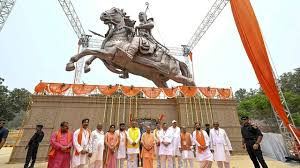UP Govt Shifts Focus from Salar Masud Dargah Mela to Suheldev Festival in Chittaura: A Cultural and Political Shift Unfolds
In a move that has stirred both cultural and political currents across Uttar Pradesh, Chief Minister Yogi Adityanath has directed officials to organise an annual mela in honour of King Suheldev of Shravasti at Chittaura Lake, Bahraich.
This development comes just a month after the long-standing, nearly 1,000-year-old mela held at the dargah of Salar Masud Ghazi in the same region was abruptly discontinued by the administration, citing “law-and-order concerns.”
The contrast between the two events — the cancellation of one religious and cultural congregation and the introduction of another — has sparked intense public discourse, historical debate, and legal wrangling.
A Statue Unveiled, A New Festival Begins
On Tuesday, Chief Minister Yogi Adityanath inaugurated a grand statue of Raja Suheldev in Chittaura, describing him as a symbol of unity, bravery, and resistance against foreign invaders.
Speaking at the event, the Chief Minister emphasized the need to revive and honour the memory of such unsung warriors who defended the nation’s cultural and civilizational values.
He added that annual fairs and “Vijayotsav” celebrations would now be held in Suheldev’s name to inspire future generations.
Suheldev, regarded by some historical accounts as a king of the Bhar Rajput community, is known for his legendary battle in 1034 AD, where he is said to have defeated and killed Salar Masud Ghazi, a commander in the army of Mahmud of Ghazni, near Bahraich.
The lake at Chittaura, where the new statue has been installed, is associated with this historic battle.
The Fall of a 1,000-Year-Old Tradition
This renewed emphasis on Suheldev’s legacy stands in stark contrast to the recent actions taken by the UP administration in May.
The district authorities, reportedly under directions from the state government, barred the dargah committee of Salar Masud Ghazi from organising the month-long traditional mela that has drawn lakhs of devotees annually, including a significant number of Hindus, for nearly a millennium. The mela was scheduled to begin on May 15.
According to police officials, the decision to halt the event was taken in the interest of public safety, especially amid heightened national tensions linked to military activities on the India-Pakistan border.
Checkpoints were set up, and all roads leading to the dargah were blocked, effectively shutting down access to the sacred site.
Contested Narratives, Polarised Symbols
The cancellation of the Salar Masud fair has deep roots in the contested historical and religious symbolism surrounding the figure of Ghazi.
Hindutva groups and organisations affiliated with the Sangh Parivar have, for years, campaigned to delegitimise the celebration of Salar Masud, calling him a symbol of “Islamic aggression” and a “foreign invader.”
They argue that glorifying a Ghaznavid commander is akin to honouring subjugation and oppression.
Some of these groups have pointed to Ghazi’s alleged participation in temple destruction campaigns under Mahmud of Ghazni. However, historians note that there is scant concrete evidence to support these claims, and no verified records exist indicating that Ghazi himself was involved in any such acts.
Contrastingly, local lore and oral traditions — especially among the region’s Hindu population — have long venerated Salar Masud as a Sufi saint and a healer who aided the poor and the sick, regardless of religion.
The dargah has historically seen more Hindu pilgrims than Muslims during the annual mela, a testament to the syncretic culture of the region.
Political Undertones and Legal Action
The shift from a celebration at the dargah to one in honour of Suheldev is not merely administrative — it is deeply political.
The Suheldev Bharatiya Samaj Party (SBSP), which draws support from backward caste communities, especially the RajbRajbhariss been a key ally of the ruling Bharatiya Janata Party (BJP) in Uttar Pradesh. The government’s emphasis on celebrating Suheldev can be seen as both a historical correction and a strategic outreach to the OBC voter base.
At the same time, the dargah committee, feeling cornered by the government’s decision, has approached the judiciary.
A member of the committee, speaking anonymously, expressed hope that the courts would uphold their right to organise the traditional mela. “This is not just about faith. It is a centuries-old cultural heritage. We are confident the judiciary will understand that and do justice,” he said.
From Corridor Politics to Cultural Symbolism
This isn’t the first time Salar Masud and Raja Suheldev have been invoked in the political arena. During the inauguration of the Kashi Vishwanath Corridor in December 2021, Prime Minister Narendra Modi had made a pointed historical reference, saying:
“The soil of this country is different from that of the rest of the world. Here, if an Aurangzeb comes, a Shivaji also rises. If a Salar Masud marches on, warriors like Raja Suheldev make him realise the power of our unity.”
This narrative framework — of foreign invader versus native hero — is increasingly being employed by the political establishment to redraw historical legacies and reshape cultural memories.
The Larger Picture
While many see the mela in Suheldev’s honour as a rightful tribute to an overlooked warrior of Indian history, others question whether this should come at the cost of suppressing long-standing traditions associated with another revered figure.
The concern is not about choosing between two legacies, but about the selective preservation of one and the erasure of another.
As Uttar Pradesh moves forward with this new cultural direction, it faces a pressing question: Can a society rooted in diversity and rich cultural traditions afford to replace its syncretic past with politically convenient versions of history? The answer may lie in how the state balances celebration with inclusion, memory with justice.

